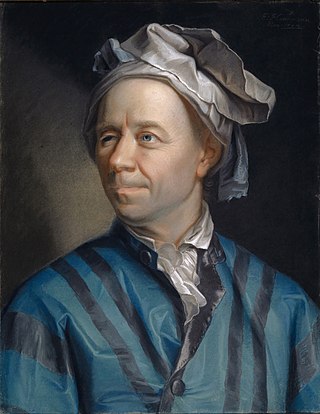In mathematics, a Mersenne prime is a prime number that is one less than a power of two. That is, it is a prime number of the form Mn = 2n − 1 for some integer n. They are named after Marin Mersenne, a French Minim friar, who studied them in the early 17th century. If n is a composite number then so is 2n − 1. Therefore, an equivalent definition of the Mersenne primes is that they are the prime numbers of the form Mp = 2p − 1 for some prime p.
This list contains selected positive numbers in increasing order, including counts of things, dimensionless quantities and probabilities. Each number is given a name in the short scale, which is used in English-speaking countries, as well as a name in the long scale, which is used in some of the countries that do not have English as their national language.
In number theory, a Woodall number (Wn) is any natural number of the form
In mathematics, a primorial prime is a prime number of the form pn# ± 1, where pn# is the primorial of pn.
In mathematics, a palindromic prime is a prime number that is also a palindromic number. Palindromicity depends on the base of the number system and its notational conventions, while primality is independent of such concerns. The first few decimal palindromic primes are:
666 is the natural number following 665 and preceding 667.
A cuban prime is a prime number that is also a solution to one of two different specific equations involving differences between third powers of two integers x and y.

The number 2,147,483,647 is the eighth Mersenne prime, equal to 231 − 1. It is one of only four known double Mersenne primes.

The largest known prime number is 282,589,933 − 1, a number which has 24,862,048 digits when written in base 10. It was found via a computer volunteered by Patrick Laroche of the Great Internet Mersenne Prime Search (GIMPS) in 2018.
In number theory, a Thabit number, Thâbit ibn Qurra number, or 321 number is an integer of the form for a non-negative integer n.
In mathematics, a prime number p is called a Chen prime if p + 2 is either a prime or a product of two primes. The even number 2p + 2 therefore satisfies Chen's theorem.
In number theory, Proth's theorem is a primality test for Proth numbers.

PrimeGrid is a volunteer computing project that searches for very large prime numbers whilst also aiming to solve long-standing mathematical conjectures. It uses the Berkeley Open Infrastructure for Network Computing (BOINC) platform. PrimeGrid offers a number of subprojects for prime-number sieving and discovery. Some of these are available through the BOINC client, others through the PRPNet client. Some of the work is manual, i.e. it requires manually starting work units and uploading results. Different subprojects may run on different operating systems, and may have executables for CPUs, GPUs, or both; while running the Lucas–Lehmer–Riesel test, CPUs with Advanced Vector Extensions and Fused Multiply-Add instruction sets will yield the fastest results for non-GPU accelerated workloads.
In number theory, a Leyland number is a number of the form
Twin Prime Search (TPS) is a volunteer computing project that looks for large twin primes. It uses the programs LLR and NewPGen. It was founded on April 13, 2006, by Michael Kwok. In number theory, it is conjectured that there are infinitely many twin primes, and this is known as the twin prime conjecture.
In number theory, primes in arithmetic progression are any sequence of at least three prime numbers that are consecutive terms in an arithmetic progression. An example is the sequence of primes, which is given by for .

A megaprime is a prime number with at least one million decimal digits.
A tetradicnumber, also known as a four-waynumber, is a number that remains the same when flipped back to front, flipped front to back, mirrored up-down, or flipped up-down. The only numbers that remain the same which turned up-side-down or mirrored are 0, 1, and 8, so a tetradic number is a palindromic number containing only 0, 1, and 8 as digits. The first few tetradic numbers are 1, 8, 11, 88, 101, 111, 181, 808, 818, ....




